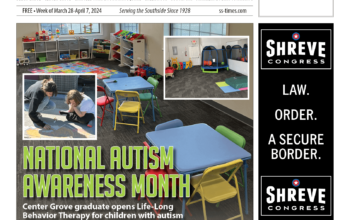By Rick Hinton
A former coworker – Dave – now deceased, read my articles in The Southside Times. He liked to debate about them afterward. He was very much interested in the paranormal and trying to wrap his mind around it all. He approached me with a question – “What is the difference between an apparition and a manifestation?” Initially I told him they were basically one and the same. Then I gave it some more thought. Maybe, not so much. …
Paranormal jargon is a foreign language for most, and an endeavor in understanding for the rest. There are those of us out there striving for some sort of understanding of metaphysical affairs and gray areas, including terminology that, for the most part, doesn’t have a niche in normal day-to-day living. Dave just wanted some answers.
Are apparitions and manifestations one and the same? In many aspects they are, yet in other areas they are completely different. An apparition (the Holy Grail, for any ghost hunter in their investigative career) is a chance encounter and doesn’t happen all that frequently. It’s a visual experience focused in on a very real physical presence, often seen with a weary set of eyes that suddenly awaken and grow to the size of silver dollars. If it’s solid and clear you should be able to make out the sex and features of the clothing, hair and face. Sometimes they are a tad on the fuzzy side and not so clear. Once an apparition is sighted, the poor paranormal investigator can never go back to any sense of normalcy. Their blood pounds for more!

A manifestation, on the other hand, can include an element of an apparition, yet it is often so much more! Manifestations become a mixture of tangible signs of a legit haunting, including: tactile (a sense of touch or scratches); auditory (noises – subtle or loud); olfactory (odors … like the odor of grandmotherly perfume we get occasionally in our bedroom); shadow figures. These can manifest in situations when mind and body are fresh and observant; or in a tired mind and body, where sleep has been elusive. This needs to be taken into consideration.
There’s two ways we perceive what we are seeing with our eyes – central and peripheral vision. Central is straight ahead, line of sight, only encompassing about 3 percent of our vision. Yet, it’s what we use 95 percent of the time. On the flip side, peripheral vision is what we see to our side – about 180 degrees – and not so clearly defined, appearing as fuzzy and non-distinct. Peripheral vision results in the majority of paranormal sightings. “I thought I saw something moving out of the corner of my eye,” is a common statement. However, how reliable is the experience?
It pays to sort it all out. It may have been something as simple as an eyelash. Or a flying insect catching your peripheral’s attention. It might have been light from the television shifting across the surface of your glasses. Or a car’s headlights filtering through the window and across the room. These experiences add a touch of mystique to a great story, but it might not be an accurate one. However, there’s those that are, and possibly an encounter in this fuzzy peripheral realm that’s the real deal: a shadow figure residing in the corner of the room, sitting still and waiting. Eventually it will move. You might just catch a glimpse, and after that, many more!
Apparition … manifestation … examples of paranormal jargon. Next week the list goes on. …

